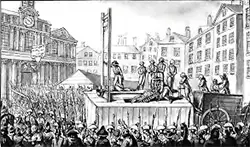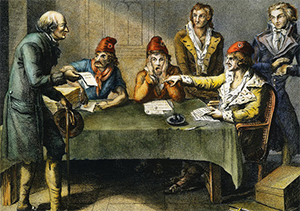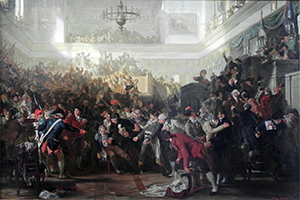The Rise and Fall of Maximilien Robespierre
Part 2: And in the End
The Committee's takeover of the government was complete on Dec. 4, 1793, when the Convention passed the Law of 14 Frimaire, or the Law of Revolutionary Government. Also known as the "Constitution of the Terror," this law gave to the Committee supreme executive power. 
One of the main aims of the Reign of Terror was to eliminate enemies of the state. With the December takeover, the Committee had the power to decide who were enemies of the state. Even though Jacques Hébert and his followers had supported the Reign of Terror and, in particular, the Law of Suspects, the Committee declared them outlaws, as it were, and sent Hébert and the other leaders of his movement to the guillotine, in March 1794. This followed a pattern of the Committee's identifying former allies as enemies and then dispatching them. Indeed, in the space of a year, the Committee had arrested an estimated 300,000 supposed enemies of the state. Robespierre this as necessary: "Terror is nothing more than speedy, severe and inflexible justice," he said in a speech to the Convention. At the same time, the Committee created the General Police Bureau, the members of which reported directly to the Committee. Resenting this action was the Committee of General Security, which was nominally in charge of policing. In the midst of the Reign of Terror, the National Convention banned slavery, issuing a decree on Feb. 4, 1794. Robespierre had long been an opponent of slavery and had denounced the slave trade on numerous occasions, including in a well-known speech to the Convention in April 1793. These actions certainly resonated with suddenly freed slaves in the French colonies, notably Haiti. In June 1794, the Committee created the Law of 22 Prairial, which put a structure around the process of identifying and punishing enemies of the state. Prisoners were denied lawyers, and witness testimony all but disappeared. Monumentally under this law, the punishment for all crimes delineated was death. This dramatically increased the number of deaths. In effect, it was nearly a straight line from arrest to execution. In the 13 months before the passage of this law, the Revolutionary Tribunal had delivered 1,220 death verdicts. In the first 49 days after the passage of this law, the number of executions was 1,376. As the summer of 1794 continued, dissent grew inside the Committee. Robespierre and Saint-Just found themselves increasingly isolated, even though they retained enormous power. Robespierre had championed the Cult of the Supreme Being, an artificial religion, and had envisioned himself its leader; the response from the French republic was not a lot of enthusiasm. Recent military victories had convinced many that the Committee no longer had the country's best interests at heart and was overstepping the bounds of its original purpose, that of defending the country from foreign enemies. Robespierre gave a speech to the National Convention on July 26, 1794, calling for purges within the Robespierre, when he knew what his fate would be, tried to kill himself. He did get a shot off but succeeded only in fracturing his jaw. He died the next day, July 28, 1794, by way of the guillotine, to which he had sent so many other "enemies of the state." First page > Champion of Equality, Powerful Ruler > Page 1, 2 |
|
Social Studies for Kids
copyright 2002–2026
David White



 On Sept. 14, 1793, the Convention handed over to the Committee the power to appoint deputies to other committees. On September 17, the Convention created the Law of Suspects, which greatly expanded the way in which people could be declared targets for arrest and punishment; following that was the Law of the Maximum, which set price ceilings in order to crack down on people engaged in price gouging. These measures concentrated in the Committee more and more power. This expansion of power resulted in more and more executions of so-called enemies of the state, notable among them Brissot and Queen
On Sept. 14, 1793, the Convention handed over to the Committee the power to appoint deputies to other committees. On September 17, the Convention created the Law of Suspects, which greatly expanded the way in which people could be declared targets for arrest and punishment; following that was the Law of the Maximum, which set price ceilings in order to crack down on people engaged in price gouging. These measures concentrated in the Committee more and more power. This expansion of power resulted in more and more executions of so-called enemies of the state, notable among them Brissot and Queen  government's various committees. The next day, Saint-Just rose to speak at the Convention but didn't finish. He found himself at the center of a series of accusations with which he would have been all too familiar. Also targeted was Robespierre. The pair were arrested, along with a handful of their supporters, but not until they had taken refuge in the Hôtel de Ville and started planning an armed rebellion. Their attempt at insurrection failed.
government's various committees. The next day, Saint-Just rose to speak at the Convention but didn't finish. He found himself at the center of a series of accusations with which he would have been all too familiar. Also targeted was Robespierre. The pair were arrested, along with a handful of their supporters, but not until they had taken refuge in the Hôtel de Ville and started planning an armed rebellion. Their attempt at insurrection failed.
